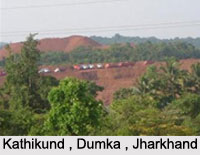 The district of Dumka in Jharkhand , in antiquity known as `Damin-e-ko` was basically formed into an administrative district by the Britishers to contain the warring Pahadiyas and the local Ghatwal kings. In this process the Santhal Tribes were allowed to infiltrate and settle in large number. After the partition of Bengal, it also played a major role in the settlement of Bengali population and thus a good number of Bengali speaking population soon dominated the social and educational life.
The district of Dumka in Jharkhand , in antiquity known as `Damin-e-ko` was basically formed into an administrative district by the Britishers to contain the warring Pahadiyas and the local Ghatwal kings. In this process the Santhal Tribes were allowed to infiltrate and settle in large number. After the partition of Bengal, it also played a major role in the settlement of Bengali population and thus a good number of Bengali speaking population soon dominated the social and educational life.
In the next phase with the beginning of transport services and a bit of business and educational institutions , a good number of Bhojpuri speaking people made their way to Dumka. Thus the urban population basically constituted of Bhojpuri and Bengali speaking people and the rural sectors specially in the interiors remained dominated by the santhals and the cast backward people. At the same time , people residing on the hills known as Pahadiyas preferred to remain outside the main stream. From the administrative point of view , Dumka become a district way back in 1965 and later on the divisional head quarter of Santhal Pargana in 1982.Till Dumka district consisted of Deoghar, Godda, Sahebgunj, Pakur and Jamtara sub divisions, Dumka remained in the hub of all administrative and Judicial activities. Thus allowing a good number of floating population.
Baba Basukinath Dham , Dumka , Jharkhand
It is situated at Jarmundi Block on Dumka Deoghar State Highway at a distance of 24 km from the Distrcit Headquarters Dumka. In whole year lacs and lacs people from different parts of country come here to worship Lord Shiva. In the month of Shravan people of several country also come here to worship Lord Shiva.
 Mallooti , Dumka , Jharkhand
Mallooti , Dumka , Jharkhand
Mallooti is a historical and religious place which is situated in Shikaripara Block on Dumka Rampurhat interstate highway at a distance of 55 km from Dumka District Headquarters. In 1860 Mallooti was made taxfree capital by the then King Basant Rai alias Basant. This Mallooti is associated with the archaeological and religious importal place for natural beauty.
Baba Sumeshwar Nath , Dumka , Jharkhand
It is a religious place which is situated in Saraiyahat Block at the distance of 60 km from district headquarters Dumka. There is a big temple of the Lord Shiva. On the eve of Mahashivaratri the people of different parts of the district come here to worship Lord Shiva in addition to daily worshiping.
Masanjore Dam , Dumka , Jharkhand
Masanjor dame or the Pearson dame on rever Mayurakshi is a picturesque place on foot hills of long range of forest clad parallel hill ranges. This place is basically a hydro electric power generating center but in the process of time it has become popular center for the tourist. With the beautiful garden on the down hill and two beautiful Dak-bunglows on the bank of the river at charm to its beauty.
Tatloie , Dumka , Jharkhand
It is a hot water Spring, situated at a distance of 15 km from the district headquarters of Dumka. It is rounded by small mounts, beautiful, attractive and greenish natural atmosphere. The water of spring is very clear and healthy.
Kathikund , Dumka , Jharkhand
 On Dumka-Pakur road , at a distance of around 25 kms. From the main town there is a block of kathikund. This place with very old establishment of sericulture and khadi production is surrounded by range hills and deep forests with a river passing between the valleys. This topographical background provides numerous sites small and big for picnic. Some of the important spots in and around the Kathikund are Nargunj, Saldoha Laprocy mission, Mahuagadhi and Gopikandar. The site under Gambhara bridge is a fascinating point for outdoor photography.
On Dumka-Pakur road , at a distance of around 25 kms. From the main town there is a block of kathikund. This place with very old establishment of sericulture and khadi production is surrounded by range hills and deep forests with a river passing between the valleys. This topographical background provides numerous sites small and big for picnic. Some of the important spots in and around the Kathikund are Nargunj, Saldoha Laprocy mission, Mahuagadhi and Gopikandar. The site under Gambhara bridge is a fascinating point for outdoor photography.
Kumdabad , Dumka , Jharkhand
This is a very beautiful picnic spot . Just 13 Kms. from the Dumka town , you find a rare view of natural beauty with small hills ,beside that smooth flowing river Mayurakshi.
Hill Range of Dumka, Jharkhand
Running south from pakur to godda.The hill range of Dumka seen parallel & terminate in th Mangalbhanga hill.
To the south east of Dumka is Ramgarh hills ferther west 2parallel renges of hills also stretch in an easterly direction from Masanjor to Ranibhal.
Beside hill ranges some hillocks are also in like (i) Lagwa hil at Nonihat under which lies the Tatloi hot water stream (ii) Hijla hill top.(iii) Sapchala hill top.(iv) Chuto pahadi.
Maluti (Temple villege on way to Rampurhat).
Hot Springs of Dumka , Jharkhand
•Tharia Pani- Near Gopi kandar on Dumka-Pakur Road. max.40km from Dumka.
•Tatloi-Near Barapalasi in BHurbhuri river on Ramgarh hills. mex.25km from Dumka.
•Nunbil max.60km from Dumka-Dumka Jamtara road near Kundhit.
•Tapat Pani-Left bank of M. river.1.25miles of Kumrabad.Airodrum road near Dhadakiya. max.10km from Dumka.
•Susum Pani-Close to village baghmara on the opposite bank of Mayurakshi river.



















